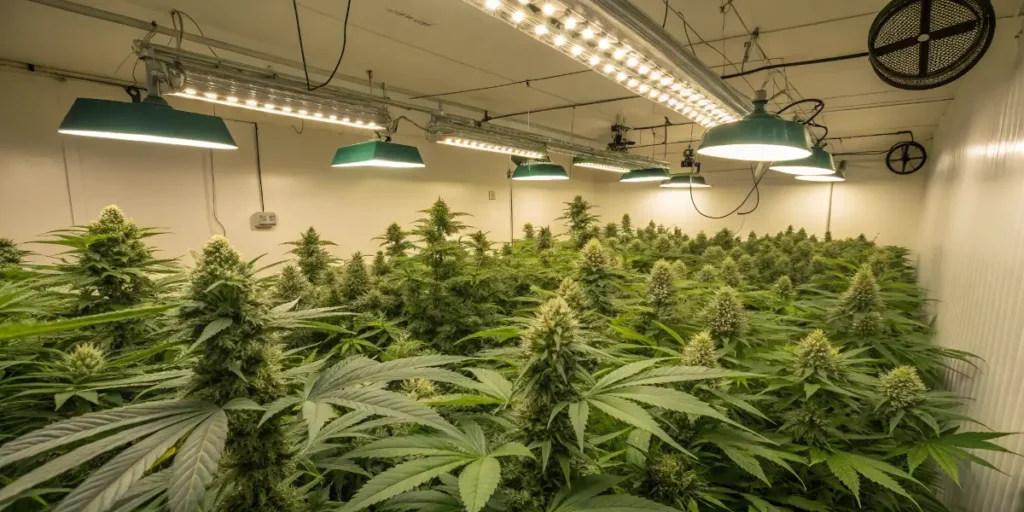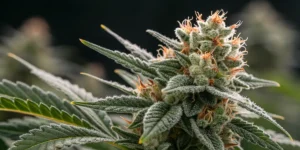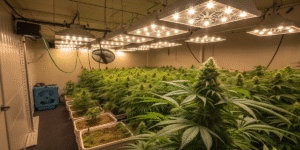Afghan Kush Auto is a popular strain known for its ease of cultivation, high resilience, and potent, earthy aroma. This auto-flowering variety is favored for its quick growth cycle and ability to thrive in various environments. Growing this strain begins with selecting quality seeds from a reputable source. Ensure that your seeds are fresh and have a high germination rate. This foundational step sets the stage for a successful cultivation experience.
Next, prepare your growing medium. This strain can be grown in soil, coco coir, or a hydroponic setup. If you choose soil, use a light, well-aerated mix rich in organic matter. When opting for coco coir or hydroponics, ensure that you provide adequate nutrients specifically formulated for cannabis. Maintaining an optimal pH balance around 6.0 for soil and 5.5 to 6.2 for hydroponics is crucial to prevent nutrient lockout.
Once your medium is ready, it’s time to plant the seeds. Auto-flowering seeds like this strain do not require a change in light cycles to start flowering, but providing a stable environment with about 18 hours of light per day encourages vigorous growth. Monitor the temperature and humidity of your grow space, keeping them around 21-26°C with 40-60% humidity during the vegetative stage and slightly lower humidity during flowering.
Watering and feeding this strain requires attention to the plant’s developmental stage. Young seedlings need less water compared to plants in the flowering stage. Over-watering is a common mistake; ensure good drainage and allow the medium to dry out a bit between waterings. Use a gentle fertilizer designed for cannabis, adjusting the nutrient mix as the plant progresses from vegetative to flowering phases.
Afghan Kush Auto typically reaches harvest around 8-10 weeks after germination. Monitor trichome color to determine the optimal harvest time most growers look for milky-white trichomes with some turning amber. Harvesting at the right time maximizes potency and ensures a rich sensory experience. After harvesting, dry and cure your buds properly to preserve their flavor and strength.
Afghan Kush Auto Strain Overview: Traits, Effects & Genetics
Afghan Kush Auto is an exquisite autoflowering cannabis strain celebrated for its robust genetics and rich heritage. Originating from the renowned Hindu Kush mountainous region on the border of Afghanistan and Pakistan, this strain has long been cherished by cannabis enthusiasts worldwide. This strain is a result of crossing the traditional Afghan Kush with Ruderalis genetics, imparting the auto-flowering characteristics, which simplify the cultivation process. Its plants are renowned for their resilience and ability to thrive in diverse environments, making them a popular choice among both novice and experienced growers.
This strain is especially admired for its distinct physical traits, becoming a sight to behold in any growing setup. This strain typically maintains a compact structure, making it ideal for indoor growers with limited space. Despite its short stature, it is known for producing dense, resinous buds blanketed with a rich layer of trichomes, reminiscent of its Afghan heritage. These plants typically flower automatically within 7-9 weeks, removing the need for light cycle adjustments, and resulting in a quick turnaround from germination to harvest.
This strain is famed for delivering soothing and powerful effects, primarily characterized by a deeply relaxing body high. This makes it an ideal strain for unwinding after a long day, as it may help alleviate stress, anxiety, and even chronic pain. The THC content generally hovers around moderate levels, ensuring an evenly balanced and mellow experience appreciated by users seeking a calming escape. The strain is often complemented by its earthy, spicy aroma and a hint of sweet fruity undertones, further enhancing its appeal among connoisseurs.
The genetic lineage of this strain plays a significant role in its popularity. By incorporating Ruderalis genetics into the classic Afghan Kush, breeders have crafted a strain that inherits the esteemed qualities of its parent while offering the added convenience of autoflowering traits. This genetic combination not only preserves the potency and flavor profile characteristic of Afghan Kush but also optimizes the adaptability and growth timeline for varied grower preferences, making Afghan Kush Auto a versatile and desirable choice in the cannabis growing community.
Optimal Environment to Grow It Successfully
This strain is a robust strain known for its ease of cultivation and resilience, making it an excellent choice for both novice and experienced growers. To successfully grow this strain, it is essential to simulate the native environment of the Hindu Kush mountains from which it originates. A stable, warm climate is optimal, with temperatures ranging between 21°C to 29°C (70°F to 85°F). Fluctuations in temperature should be minimized to prevent stress that could impact growth and yield.
Proper lighting is critical for the successful cultivation of Afghan Kush Auto. This auto-flowering strain requires long periods of light; ideally, it should receive 18 to 24 hours of light daily. While it thrives under powerful indoor lights such as LEDs or HPS, this strain can also flourish outdoors in sunny regions. The key is consistent light exposure to encourage healthy vegetative growth and prolific flowering.
Despite its resilience, this strain performs best in well-aerated soil with good drainage. Organic soil with added amendments like perlite or vermiculite can improve aeration and water retention. Keeping the soil pH between 6.0 and 7.0 will promote nutrient uptake and prevent nutrient lockout. It’s essential to water the plant appropriately; overwatering can lead to root rot while underwatering may stunt growth.
Humidity control is another critical aspect of creating an optimal environment. This strain, like many indica strains, prefers lower humidity levels, especially during the flowering stage. Keeping humidity between 40% and 50% helps prevent mold and mildew while promoting resin development. Using a dehumidifier in your grow space can help regulate moisture levels effectively.
Air circulation should not be overlooked. Proper air movement prevents stagnant air and reduces the risk of pests and diseases. Fans can be employed to ensure a gentle breeze around the plants, reinforcing strong stems and encouraging better growth. By maintaining these environmental conditions, growers can ensure a healthy and bountiful yield from the resilient Afghan Kush Auto.
Grow Room Setup for Afghan Kush Auto Plants
Setting up a grow room for Afghan Kush Auto requires a precise blend of conditions to ensure optimal growth and yield. As a reliable and robust strain, Afghan Kush is well-suited to indoor growing environments, but it thrives best when specific parameters are met. The first consideration should be space; these plants remain relatively compact, making them ideal for limited indoor setups. Ensure that each plant has enough room to grow, typically around 1×1 feet per plant, to avoid overcrowding and suffocation.
Lighting is a critical aspect of the grow room setup. This plants benefit significantly from a consistent light schedule, utilizing high-quality LED or HID lights to mimic natural sunlight. Given its autoflowering nature, a consistent light cycle of 18/6 (18 hours on, 6 hours off) throughout its life cycle is often recommended. This setup promotes vigorous growth and maximizes efficiency in photosynthesis, contributing to healthier plants and higher yields.
Maintaining the right temperature and humidity levels is crucial for the health of this plants. These plants prefer warmer temperatures, ideally between 70°F to 85°F (21°C to 29°C) during the day and slightly cooler at night. Humidity should be closely monitored, keeping it around 40-50% during the vegetative stage and 30-40% during the flowering stage to prevent mold and mildew, which can thrive in overly humid conditions.
Adequate ventilation is another important factor to consider. This plants require good airflow to maintain temperature, humidity levels, and to strengthen stem growth. Invest in fans or an exhaust system to facilitate air exchange. This helps in eliminating heat build-up and ensures a supply of fresh CO2, which is vital for photosynthesis. Constant air movement also minimizes the risk of pests and diseases.
Consider the grow medium and nutrient regimen. Auto-flowering strains like Afghan Kush typically prefer a light, airy substrate like a mix of coco coir with perlite. This allows roots to spread and access nutrients more efficiently. Begin feeding with reduced nutrient levels, then gradually increase as the plants grow. Monitoring pH levels, ideally around 6.0 to 7.0, ensures optimal nutrient absorption.
Indoor Growing Tips for Afghan Kush Auto
When growing Afghan Kush Auto indoors, one of the first considerations is the lighting setup. This strain thrives under high-intensity discharge lights or LED grow lights due to its robust nature. Adequate lighting ensures optimal growth and maximizes yield. Ideally, a cycle of 18-20 hours of light per day will mimic long summer days, encouraging the plant’s vegetative state before it naturally transitions into flowering. Adjusting lights to maintain an ideal distance from the canopy will prevent light burn and promote healthy growth.
Temperature and humidity are crucial factors for the successful cultivation of this strain indoors. The optimal temperature for this strain during the day ranges from 70-85°F (21-29°C) and slightly cooler temperatures at night. Maintaining humidity levels at around 60% during the early vegetative stage and reducing it to 40-50% during flowering will help in preventing mold and enhance resin production. A reliable hygrometer and thermometer will assist in monitoring these conditions ensuring a cozy environment for your plants.
This strain is highly resilient but benefits greatly from a regimented feeding schedule. Use a balanced nutrient solution that includes essential macro and micronutrients, ensuring not to overfeed to avoid nutrient burn. Autos typically require lighter feeding than photoperiod strains. It’s advisable to start with quarter strength nutrients and gradually increase as the plant shows signs of nutrient uptake. Keeping a clear watering schedule that allows the soil to dry slightly between waterings will help in preventing overwatering, a common pitfall.
Training techniques such as Low-Stress Training (LST) can be employed to maximize light penetration and increase yields without hindering the plant’s natural growth cycle. Given the relatively shorter life cycle of autoflowers, it is important to start training early and monitor plant stress to avoid hampering the flower development. As this strain matures, consistently monitoring and maintaining the proper pH levels between 6.0-6.5 is fundamental to ensuring nutrient absorption and healthy growth.
Don’t overlook the importance of air circulation in your grow space. Proper ventilation prevents mold and pest infestations, improves CO2 levels, and strengthens plant stems. Use oscillating fans and exhaust systems to maintain a gentle breeze, which encourages healthy plant development. By following these indoor growing tips, this strain can reward growers with a potent, aromatic yield, reminiscent of its rich Afghan heritage.
Outdoor Growing Tips for Afghan Kush Auto
Afghan Kush Auto is a resilient and robust cannabis strain, particularly suitable for outdoor cultivation due to its automatic flowering capabilities and hardy genetics. The plant inherits its resilience from its parent strains, making it particularly well-suited for outdoor environments. This strain is renowned for its forgiving nature, making it an excellent choice for both novice and experienced growers looking to maximize their harvest in an outdoor setting.
When selecting the optimal location for growing this strain outdoors, prioritize a spot that receives ample sunlight. This strain flourishes under full sun for at least six to eight hours a day. Positioning your plants in a sunny, south-facing area will enhance their growth potential. Additionally, ensure the site has good air circulation to prevent mold and mildew, which can be detrimental to cannabis plants, especially in more humid climates.
Soil quality is another vital factor in the successful cultivation of this strain outdoors. This autoflowering strain thrives in well-draining soil enriched with organic matter. Amend the soil with compost or perlite to enhance drainage and nutrient availability. Regularly monitoring soil pH is also crucial, as cannabis prefers a slightly acidic range of 6.0 to 6.5. This allows the plant to effectively uptake essential nutrients and flourish throughout its growth cycle.
Watering practices must be adjusted to meet the needs of outdoor-grown this strain. While this strain is relatively drought-tolerant, consistent and balanced watering is crucial to ensure optimal growth. Over-watering can lead to root rot, so ensure the soil is dry to the touch before the next watering session. During hot weather, increase watering frequency to prevent dehydration and stress.
Remaining vigilant regarding potential pests and environmental stressors is key to a successful harvest of Afghan Kush Auto outdoor plants. Regular inspections for common pests like aphids and caterpillars can prevent infestations, while organic insecticides or neem oil can serve as effective deterrents. Watch for extreme weather conditions and consider protective measures such as hoop houses or temporary covers to shield plants from storms or excessive rain.

How to Germinate & Propagate Afghan Kush Auto
Germinating Afghan Kush Auto seeds is an essential first step in cultivating this popular cannabis strain. The process begins by acquiring high-quality seeds from a reputable source. One effective germination method is the paper towel technique. Start by moistening two paper towels with distilled water. Place the Afghan Kush seeds between the paper towels and then position them on a plate. Cover the seeds with a second plate to keep them in the dark and maintain a warm environment of about 70-75°F (21-24°C). This simulates the natural conditions Afghan Kush seeds need to sprout.
Check the seeds daily and ensure that the paper towels remain moist. Within 24 to 72 hours, you should see small roots, known as radicles, emerging from the seeds. Once these roots reach about a quarter-inch in length, the seeds are ready for planting. Transplant them gently into your chosen medium. As this strain is an autoflowering strain, it is crucial to plant the seeds in their final pot from the beginning to minimize the risk of stunting their growth due to transplant shock.
When it comes to propagating this strain, using cuttings is not recommended as autoflowering strains do not respond well to this method. Instead, focus on optimal growing conditions for the seedling stage. Ensure your growing medium, whether soil or coco coir, is well-draining and has a balanced pH. Provide adequate light using either full-spectrum LED lights or natural sunlight for at least 18 hours a day. With patience and care, your plants will thrive and reach their full potential in around 8 to 10 weeks.
Maintaining proper environmental conditions is vital throughout the germination and propagation stages. Monitor temperature and humidity levels closely, keeping humidity at around 65-70% during the early seedling phase and gradually lowering it as the plant matures. As Afghan Kush Auto is an autoflowering strain, these plants thrive with less stress, making them an excellent choice for beginners in cannabis cultivation. By following these steps, you’ll ensure a healthy start for your plants, leading to a rewarding harvest of potent Afghan Kush buds.
Vegetative Stage
The vegetative stage is a crucial period for your plants, as this is when they develop the robust structure necessary for successful flowering. This phase typically lasts around three to six weeks, depending on environmental conditions and care practices. It is essential to provide adequate light, as autoflowers like Afghan Kush need a consistent light schedule, ideally between 18 to 24 hours of light per day. This will facilitate strong photosynthesis processes that bolster plant growth.
During the vegetative stage, ensuring optimal temperature and humidity conditions is vital. Afghan Kush Auto plants thrive in temperatures ranging from 70°F to 85°F (21°C to 29°C) during the day and slightly cooler at night. Humidity levels of 40% to 70% are ideal. Keeping your growing environment within these parameters helps prevent stress that can stunt growth. Using fans or ventilation systems can assist in maintaining proper airflow and avoiding mildew or mold, often exacerbated by stagnant air and high humidity.
Nutrient management is another key aspect of nurturing your plants during the vegetative stage. Autoflowers require a balanced nutrient solution, rich in nitrogen, which is crucial for leafy growth. A high-quality nutrient mix designed for the vegetative stage of cannabis should be used to supplement your plants’ nutritional needs. However, be cautious to avoid nutrient burn which occurs from overfeeding; start with lower doses and gradually increase as needed, observing how your plants respond.
Additionally, proper watering practices cannot be overstated. These plants, like other autoflowers, prefer a ‘less is more’ approach with watering. Overwatering is a common mistake that can lead to root rot and other health issues. It’s best to ensure that the top inch of the soil is dry before re-watering. Utilizing containers with adequate drainage can also prevent water from pooling at the roots and facilitate healthy growth during this stage.
Implementing techniques like low-stress training (LST) during the vegetative stage can further enhance the growth of your plants. LST involves gently bending and securing branches to encourage more even light exposure and an overall bushier plant structure. This approach is particularly beneficial for autoflowers as they have a limited vegetative period. Nurturing your Afghan Kush Auto with these considerations in mind will set the foundation for a fruitful flowering stage and a bountiful harvest.
Flowering Afghan Kush Auto: What to Expect
This strain is a highly sought-after strain for its resilience and robust genetics, making it a favorite among both novice and experienced growers. As it transitions into the flowering phase, typically around 8 to 9 weeks post-germination, growers can expect a swift development due to its autoflowering nature. It does not rely on light cycles to flower, which makes the timing more predictable and cultivation relatively straightforward. This trait allows Afghan Kush Auto to thrive both indoors and outdoors, adapting well to different environments and climates.
During flowering, Afghan Kush Auto plants will be admired for their bushy structure, often reaching heights between 60 to 90 cm indoors and potentially up to 120 cm outdoors, while cultivating relatively rich yields. The buds of these plants develop tightly packed and dense, forming a thick coat of resin that shimmers in light due to its high trichome production. This results in a potent aromatic signature characterized by earthy tones mixed with subtle hints of spice and a whiff of pungency that is classic to Afghan strains.
Growers should anticipate a significant increase in odor during this period. Utilizing carbon filters is recommended to manage the scent, especially if privacy is a concern. It’s crucial during the flowering stage to maintain an optimal climate with consistent temperature and humidity levels to prevent mold, which is a risk due to the strain’s dense bud structure. Regular monitoring and basic pruning can also enhance airflow and light penetration, further promoting healthy bud development.
When it comes to feeding, this strain demands a balanced nutrient regimen. However, it’s important to avoid over-fertilization, as autoflowers tend to be more sensitive to nutrient burn. Tailor the feeding schedule to provide adequate amounts of phosphorus and potassium, which are key for plump buds in the flowering stage. Patience and attentive care during this time will reward growers with bountiful harvests rich in potent cannabinoids, particularly THC, offering a deeply relaxing experience accompanied by therapeutic benefits.
Fertilizers & Nutrient Schedule
Growing Afghan Kush Auto successfully requires a strategic approach to feeding and ensuring that your plants receive the right balance of nutrients is crucial for optimal growth. During the initial stages of its lifecycle, this strain benefits from a balanced start. As a foundational step, it’s essential to use a gentle vegetative nutrient mix with a higher ratio of nitrogen. This can typically be achieved with a balanced N-P-K ratio of around 3-1-2 to 5-2-3, ensuring that the plants have adequate nitrogen for robust vegetative growth.
As this strain progresses into the flowering phase, it’s vital to adjust the nutrient schedule to support bud development. This period typically demands an elevated intake of phosphorus and potassium. A flowering nutrient mix might emphasize an N-P-K ratio that leans towards higher phosphorus and potassium levels, such as 1-5-6 or 2-4-7. These nutrients are crucial for bud formation and density, helping to maximize the yield and potency of your plants.
Monitoring and adjusting the pH levels of your nutrient solution is another important aspect of feeding Afghan Kush Auto. Cannabis plants typically thrive in a pH range of 5.8 to 6.5 for soil-based grows, which allows optimal nutrient absorption. Regularly checking and maintaining the pH level will help prevent nutrient lockout, ensuring that your plants receive all the essential nutrients they need for healthy growth throughout their lifecycle.
Feeding frequency and nutrient concentration can vary based on environmental conditions and phenotypic expressions of this strain. Generally, it’s recommended to start with a conservative approach, especially if you’re new to growing this strain. Begin with half the recommended dose of nutrients and gradually increase based on plant response. Keep an eye out for any signs of nutrient burn or deficiency, such as yellowing leaves or burnt tips, and adjust your feeding regimen accordingly.
In the case of this strain, organic amendments and supplements can also be beneficial. Enhancers like compost teas or seaweed extracts can provide micro-nutrients and beneficial microbes, promoting healthy root systems and overall plant vitality. Regularly flushing the growing medium can also help remove any residual salts and prevent potential nutrient lock-up as your Afghan Kush Auto nears harvest. By following a well-structured feeding schedule and adapting to your plants’ specific needs, you can optimize growth, enhance cannabinoid production, and achieve a bountiful harvest.

Pest and Disease Prevention for Healthy Cannabis Plants
Growing Afghan Kush Auto, like any cannabis strain, requires vigilance to prevent pests and diseases that can compromise plant health. The first step in pest and disease prevention is to ensure a clean growing environment. Regularly sanitize tools, containers, and your growing area to minimize the risk of contamination. Ensure that your soils and substrates are sterilized to prevent the entry of pathogens initially.
An adequate airflow is essential for maintaining a healthy environment for your plants. Good air circulation helps to reduce humidity, which can be conducive to mold and mildew growth. Install oscillating fans if you are growing indoors, or place your plants in a well-ventilated outdoor area to promote airflow. High humidity environments are breeding grounds for powdery mildew and mold, so monitoring and controlling humidity levels is critical.
Conduct regular inspections of your plants, checking leaves, stems, and soil for signs of pests such as spider mites, aphids, or whiteflies. Early detection is crucial in preventing infestations from spreading. Employ natural pest control methods such as introducing beneficial insects like ladybugs or predatory mites that feed on harmful pests. Neem oil is another organic treatment that can be applied to deter pests while being safe for the plant and the environment.
Maintaining healthy plants also involves ensuring optimal nutrient delivery and avoiding over-fertilization, which can weaken plant immunity and invite diseases. A balanced nutrient regimen tailored to the specific growth stage of the plant will bolster its resilience against diseases. Remember that too much nitrogen, especially during the flowering stage, can make plants more susceptible to pests and fungal infections.
Practice crop rotation or occasionally reorganize your indoor grow space to disrupt pest life cycles. These changes can lessen the chance of recurring pest issues. By taking a thorough approach to pest and disease prevention, you can ensure that your plants remain healthy and thrive, yielding a bountiful and potent harvest.
Harvesting & Drying Afghan Kush Auto the Right Way
Afghan Kush Auto is a popular strain among cannabis cultivators due to its robust nature and quick flowering cycle. As you approach the harvesting phase, it’s crucial to monitor the plant’s trichomes. They are the best indicators of ripeness. Typically, you’ll want a mix of milky white and a few amber trichomes to ensure optimal potency and flavor. Timing is everything, as premature harvesting can result in diminished cannabinoid content, while late harvesting may affect taste and aroma. Detailed observation and patience are vital at this stage.
When it’s time to harvest, begin cutting the plant at the base, and carefully remove large fan leaves. These broad leaves hold little to no cannabinoid content and contribute more to weight than quality. Handling the plant gently, bear in mind to avoid bruising the flowers, as this can damage the delicate trichomes. Use clean, sharp tools to make clean cuts, reducing stress on the plant and preventing the spread of diseases or mold during the drying phase. The harvest process should be executed in a calm yet efficient manner to preserve the plant’s prime condition.
After harvesting this strain, the next vital step is drying. This process should be conducted in a dark room with controlled temperature and humidity, ideally around 60-70°F (15-21°C) and 50-60% humidity. Hang the branches upside down, ensuring proper air circulation around each of them, which helps prevent mold development. The drying period usually lasts about a week to ten days, depending on environmental conditions. Should the outer parts of the buds feel dry to the touch while the stems snap rather than bend, you are ready to proceed to curing.
Post drying, curing is essential for enhancing the quality and smoothness of this strain. Place the dried buds in airtight containers, filling them about three-quarters full, and store these in a cool, dark place. Open the containers daily for the first week to allow fresh air exchange and to release excess moisture. This process, known as burping, aids in flavor development and ensures that the chemical profile of your cannabis reaches its full potential. A well-executed curing process can take several weeks but results in a superior end product.
Afghan Kush Auto Strain Type: Indica, Sativa or Hybrid?
Afghan Kush Auto is predominantly an Indica strain, celebrated for its robust and resilient genetics that find their origin in the harsh mountainous regions of Afghanistan. This auto-flowering version has maintained the true essence of a traditional Indica, known for its bushy structure and broad, dark green leaves. This strain inherits the rich lineage of pure Indica landrace strains, which have become the backbone for numerous cannabis hybrids worldwide. Its auto-flowering nature allows it to thrive with minimal interference, making it an ideal choice for growers seeking a reliable Indica-dominant plant.
This strain showcases the classic Indica characteristics, characterized by its compact stature and dense bud formation. Unlike Sativa strains that typically grow tall and lanky, this strain stays relatively short, which is perfect for discrete indoor cultivation. Its growth pattern is in stark contrast to the slender appearance of Sativa plants, providing a clear visual indicator of its Indica dominance. The strain also boasts a faster growth cycle due to its auto-flowering genetics, transitioning from seed to harvest in a short span of time while still delivering the quintessential relaxing effects of an Indica.
This strain is particularly favored by those looking for the profound relaxing effects that come with Indica strains. Afghan Kush Auto provides a deeply sedative experience, often associated with relaxation and a sense of calm that can be attributed to its near-pure Indica heritage. While it might not offer the energizing lift of a Sativa or the balanced high of a hybrid, this strain excels in delivering a heavy, tranquil body stone that’s perfect for unwinding after a long day or preparing for restful sleep.
To sum up, this strain is widely recognized as an Indica-dominant strain, capturing all the essential qualities that have made Indicas prized by cultivators and consumers alike. Its genetic lineage traces back to some of the oldest cannabis strains known to exist, and its auto-flowering capabilities offer a modern twist that simplifies cultivation without sacrificing quality or potency. Growers and enthusiasts alike appreciate the strain’s ease of cultivation and the unmistakable, soothing effects synonymous with Indicas.
Key Benefits for Cultivators
This strain offers a unique advantage to cultivators due to its robust genetic lineage and adaptable growing characteristics. Originating from the Hindu Kush mountain range, this strain is known for its resilience and ability to thrive in various climates. Its autoflowering quality means it transitions from the vegetative stage to the flowering stage without the need for a change in light cycle, making it an ideal choice for novice growers and those looking to streamline the cultivation process.
One of the primary benefits of growing this strain is its relatively short lifecycle. Typically, from seed to harvest, it only takes 8 to 10 weeks, which allows cultivators to achieve multiple harvests in a single growing season. This quick turnaround time not only maximizes output but also enables growers to react swiftly to market demands or personal supply needs. Moreover, its short stature, usually ranging from 60 to 90 cm, makes it suitable for both indoor and outdoor setups, even in limited spaces.
The strain is renowned for its resilience, exhibiting natural resistance to common pests and mold, which reduces the need for intense maintenance and careful monitoring. This hearty nature makes Afghan Kush Auto especially appealing to new growers who may not yet have the experience needed to handle more finicky plants. Additionally, its ability to handle fluctuations in temperature and humidity makes it a forgiving and easy-to-manage option for growers in various environments.
This strain is prized for its strong, soothing effects, making it a popular choice among consumers seeking relaxation and stress relief. Its rich terpene profile produces earthy, woody flavors that enhance the overall consumption experience. By growing this strain, cultivators can ensure a steady supply of high-quality cannabis that resonates with a wide range of users, contributing to its continuous popularity in the market.
Potential Challenges When Growing Afghan Kush Auto
Growing Afghan Kush Auto can be an exciting endeavor, but it is not without its challenges. One of the primary issues growers face is managing its environmental needs, particularly with respect to temperature and humidity. This strain thrives in a stable climate, and fluctuations in temperature can stress the plants, potentially affecting their growth and yield. Ensuring a consistent temperature, optimal for cannabis, of around 70-80°F (21-27°C) with a relative humidity of 40-50% during the vegetative stage and 30-40% during flowering is essential for healthy growth.
Another potential challenge is the susceptibility to pests and diseases, which is a common concern for many cannabis strains. This strain is particularly prone to spider mites, aphids, and powdery mildew, which can wreak havoc if not managed promptly. Regular inspection of plants for any signs of infestation or disease, combined with preventive measures such as maintaining cleanliness in the grow area and using organic pest control solutions, can help mitigate these issues. Growers should keep the air circulation optimal and ensure that plants do not get too dense to minimize mildew risks.
Nutrient management can also pose a challenge when cultivating Afghan Kush Auto. These plants typically require a balanced feeding schedule to support their growth, especially because they have a relatively short lifecycle typical of autoflowering strains. Overfeeding can lead to nutrient burn, while underfeeding may stunt growth. It is crucial to monitor pH levels and nutrient concentrations closely, using a well-balanced nutrient mix designed for cannabis, to ensure plants receive what they need at each growth stage without excesses that can harm them.
Mastering the light cycle is vital for autoflower varieties like this strain. Unlike photoperiod strains, they do not rely on changing light schedules to flower. However, they still require adequate light to maximize photosynthesis and growth. Providing consistent lighting, typically between 18-24 hours of light, can optimize growth conditions, yet this setup can be energy-intensive and may increase operational costs. Making adjustments to balance costs with plant requirements is essential for a successful grow.
Here’s What You Need to Know
Afghan Kush Auto is a highly sought-after cannabis strain that appeals to both novice and experienced growers due to its unique characteristics and robust nature. This autoflowering variety descends from the traditional Afghan Kush, a strain renowned for its pure Indica roots and richly potent effects. The autoflowering nature means that it has been cross-bred with Ruderalis, allowing the plant to flower automatically, independent of the light cycle. This trait provides a significant advantage to growers who can expect a faster, easier cultivation cycle compared to photoperiod strains.
One of the primary reasons growers opt for this strain is its resilience and ease of growth. This strain is well-suited for both indoor and outdoor environments, showcasing remarkable adaptability to different conditions. Its hardy genetics ensure resistance against common pests and diseases, making it an excellent choice for beginners who might be concerned about the intricacies of cannabis cultivation. Additionally, its compact stature fits snugly into various spaces, providing discretion and strategic placement for stealth cultivation.
Apart from its cultivation benefits, this strain delivers exceptional quality in terms of effects and aroma. Known for its profoundly relaxing and sedative effects, this strain is lauded for medicinal use, especially in alleviating pain, stress, and insomnia. The aromatic profile is equally enticing, often rich in earthy and woody notes that resonate with traditional Afghan strains. This powerful combination of therapeutic potential and appealing scent makes it a worthwhile investment for users seeking both recreational and medical benefits.
Therefore, investing in this strain is largely seen as a worthy decision, especially for those seeking a low-maintenance, high-quality crop. Its autoflowering nature, coupled with the strain’s resilient genetics and compact size, afford growers a hassle-free experience with a generous yield of potent, aromatic buds. Ultimately, whether you are a beginner or a seasoned cultivator, this strain presents a practical and rewarding choice, promising both ease of growth and potent effects.

FAQs about Afghan Kush Auto
What is Afghan Kush Auto?
Afghan Kush Auto is an autoflowering cannabis strain known for its resilience and potency. It is a derivative of the traditional Afghan Kush strain, which originates from the Hindu Kush mountains. This auto-flowering version is engineered to automatically switch from the vegetative stage to the flowering stage, making it ideal for growers seeking a faster and more straightforward cultivation experience without the need to manipulate light cycles.
What are the typical effects of consuming Afghan Kush Auto?
Individuals who consume Afghan Kush Auto typically report a relaxing body high, which is characteristic of Indica-dominant strains. It’s renowned for easing stress and creating a calming effect, making it popular among those with anxiety or insomnia. Additionally, due to its potent nature, it may induce a sense of euphoria, rendering it effective for uplifting mood while also aiding in pain relief.
How long does Afghan Kush Auto take to grow from seed to harvest?
Afghan Kush Auto is known for its relatively quick cultivation cycle. From seed to harvest, it typically takes between 8 to 10 weeks. Its auto-flowering nature allows for a faster turnaround compared to photoperiod strains, which can take significantly longer. This expedited growth cycle makes it a favorite among growers who aim for multiple harvests within a single year.
What are the ideal growing conditions for Afghan Kush Auto?
Afghan Kush Auto thrives in a variety of growing environments, but it flourishes best in sunny climates with warm temperatures. It is a hardy plant, resistant to common pests and mold, making it suitable for indoor and outdoor cultivation. For indoor growing, maintaining temperatures between 70-85°F with optimal humidity levels of 40-50% during the flowering stage is recommended to achieve the best yield and potency.
What are the expected yield and flavor profile of Afghan Kush Auto?
The yield of Afghan Kush Auto can range between 300-400 grams per square meter indoors and around 30-60 grams per plant outdoors, depending on the growing conditions and care provided. Its flavor profile is typically earthy with hints of pine and spicy undertones, along with subtle notes of sweetness and hash. This unique blend of flavors makes it a preferred choice for connoisseurs looking for a classic Indica experience.





